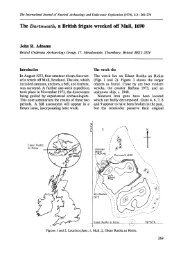port henderson : past & present - Royal Commission on the Ancient ...
port henderson : past & present - Royal Commission on the Ancient ...
port henderson : past & present - Royal Commission on the Ancient ...
You also want an ePaper? Increase the reach of your titles
YUMPU automatically turns print PDFs into web optimized ePapers that Google loves.
To <strong>the</strong> west of <strong>the</strong> lochs Wentworth describes a steep and rocky knoll, Cnoc a’ Chomharraich<br />
and under this outcrop of rock were <strong>the</strong> ruins of a house that Se<strong>on</strong>achán lived in. Se<strong>on</strong>achán, or John,<br />
was a shepherd. Local informati<strong>on</strong> states that John (s<strong>on</strong> of a Finlay MacLean) was an Opinan shepherd<br />
and <strong>the</strong> ruins are within <strong>the</strong> Opinan township. However, against a bank of rocks within <strong>the</strong> Port<br />
Henders<strong>on</strong> comm<strong>on</strong> grazing is a sheltered and protected part where <strong>the</strong>re are traces of what might be<br />
blackened areas, maybe from fire. This is known locally as <strong>the</strong> ‘chimney’. (Children in <strong>the</strong><br />
1950s/1960s used to make fires in this area according to a former resident).<br />
Just outside Gairloch <strong>on</strong> <strong>the</strong> road from Poolewe <strong>the</strong>re is a large<br />
boulder called <strong>the</strong> ‘Shoe St<strong>on</strong>e’ where walkers to church in Gairloch<br />
would stop in order to put <strong>on</strong> <strong>the</strong>ir shoes. In Port Henders<strong>on</strong> <strong>the</strong>re is <strong>the</strong><br />
‘St<strong>on</strong>e of <strong>the</strong> Urine’, Clach an Fhuail, because it was a c<strong>on</strong>venient<br />
place for people walking al<strong>on</strong>g <strong>the</strong> road to stop for <strong>the</strong> call of nature!<br />
This rock can still be seen but today it is enclosed in a fr<strong>on</strong>t garden of a<br />
bungalow situated <strong>on</strong> an ap<str<strong>on</strong>g>port</str<strong>on</strong>g>i<strong>on</strong>ment of croft 10.<br />
The 'urine' st<strong>on</strong>e<br />
On <strong>the</strong> shore to <strong>the</strong> east of <strong>the</strong> ruins at Port a’ Sgùmán <strong>the</strong>re is a<br />
rock outcrop called a’ Chreag Mhaol, <strong>the</strong> ‘bare rock’, (OSR) which extends for about 50 metres al<strong>on</strong>g<br />
<strong>the</strong> shore and which is about six metres high above <strong>the</strong> low tide line. Its tip is cut off by a narrow sea<br />
channel, around three to four metres, through which, it is said, a dinghy could pass except when <strong>the</strong><br />
tide was at its lowest. About 100 metres to <strong>the</strong> east of this rock is a row of flat, sloping rocks at <strong>the</strong><br />
bottom of <strong>the</strong> beach. More rock slabs and a small rock pinnacle can be seen at very low tide. These are<br />
<strong>the</strong> ‘little skerries’, na Sgeirean Beaga. There are slight indicati<strong>on</strong>s of a dinghy beaching place in a<br />
stretch of shingle about 20 metres to <strong>the</strong> east of <strong>the</strong>se rock slabs. This was <strong>on</strong>ce used for fishing boats<br />
and is called Port Alasdair Dhuinn, or ‘brown(-haired) Alasdair’s <str<strong>on</strong>g>port</str<strong>on</strong>g>’. Wentworth gives no indicati<strong>on</strong><br />
as to who was Alasdair and locally no-<strong>on</strong>e has any fur<strong>the</strong>r informati<strong>on</strong>. Achlais a’ Sgùmán, <strong>the</strong> ‘oxter’<br />
or ‘armpit’, is an anchorage which was <strong>on</strong>ce well-used by <strong>the</strong> boats in this area of Port Henders<strong>on</strong>.<br />
Ano<strong>the</strong>r <str<strong>on</strong>g>port</str<strong>on</strong>g> in this area is named Port an t-Seada, <strong>the</strong> ‘Port of <strong>the</strong> Shed’. The beaching place<br />
for a small boat or dinghy is still visible from <strong>the</strong> shore that has been cleared of st<strong>on</strong>es. It gained its<br />
name because it is opposite <strong>the</strong> site where <strong>the</strong>re was <strong>on</strong>ce a<br />
boat-building shed bel<strong>on</strong>ging to Roderick MacKenzie. These<br />
MacKenzies lived <strong>on</strong> croft 15 (but from 1900 <strong>the</strong>y also paid rent<br />
for croft 12, see pp. 20/45/48/49). (Also see p.14 for <strong>the</strong> story of<br />
Roderick MacKenzie and <strong>the</strong> mermaid).<br />
There is yet ano<strong>the</strong>r beaching place which is still visible<br />
as a narrow slipway, <strong>on</strong>ce cleared of st<strong>on</strong>es, and about 130<br />
A beaching place<br />
metres to <strong>the</strong> north of Port an t-Seada. This is called <strong>the</strong> ‘little<br />
<str<strong>on</strong>g>port</str<strong>on</strong>g>’, Am Port Beag. (In recent gales many st<strong>on</strong>es were washed up making this <str<strong>on</strong>g>port</str<strong>on</strong>g> unusable).<br />
Just behind this beach <strong>the</strong>re is an area covered with bracken and grassy knolls which were <strong>on</strong>ce<br />
10



